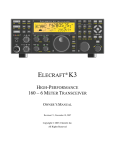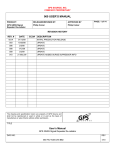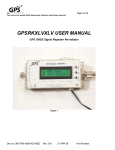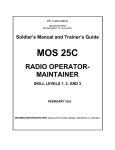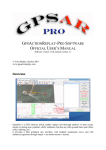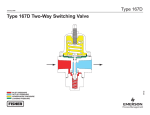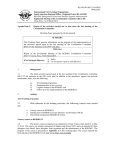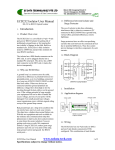Download White Paper – A Case Study of GPS Retransmission Inside Military
Transcript
White Paper – A Case Study of GPS Retransmission Inside Military Ground Vehicles Brian Paul February 2012 Introduction Global Positioning System (GPS) technology has seen increased use in many different military applications worldwide, beyond navigation. Soldiers use GPS to enhance situational awareness on the battle field with systems such as Land Warrior, Blue Force Tracker, and various electronic mission planning tools. GPS applications for Airborne Soldiers provide guidance to the drop zone in night or inclement weather operations. In the case of Joint Precision Airdrop Systems (JPADS), GPS guidance receivers provide navigation and steering commands to guide the payload to the drop zone. GPS enabled asset tracking may provide current position and status of high value assets, such as VIPs, nuclear weapons, etc. In training applications, GPS technology may be used to track the participating assets, scoring the exercise and enabling a far more instructive de-brief. In all of the examples above and in many other GPS enabled military applications, it frequently becomes necessary for these GPS receivers to operate in locations where the GPS signals are normally not available. Many times, this environment is the inside of a military ground vehicle such as the M1165 HMMWV, M1126 Stryker, GMV, M2A3 Bradley IFV, or MRAP. This white paper will discuss how GPS Retransmission can be an effective solution to the problem of GPS denied environments for some GPS enabled applications. Specifically, this paper will concentrate on GPS retransmission systems as they apply to military ground vehicles, including specific capabilities and requirements for these systems. What is GPS Retransmission? GPS Retransmission, or GPS Repeating, is the art of making the live GPS signal available to handheld or mobile GPS applications at locations where the signal is not otherwise available. Proven applications include the following: • • • • In the crew compartment of a military vehicle In the cargo compartment of a military aircraft In the garage or hangar bay of a military maintenance facility In the final assembly stage of a military equipment manufacturer Ground Vehicle Applications, Benefits, and Added Value When GPS receivers, or specifically the receiver’s antennas, are inside of vehicles (i.e., DAGR mounted inside an MRAP) or buildings without a Line Of Sight (LOS) view of the GPS satellites, the receivers will not provide navigational or position information. Multipath or other errors in the received data, can lead to erroneously displayed information on the DAGR or commercial GPS receiver. The soldier or user may not be aware of this data error, leading to incorrect coordinates being called out for air support, medevac location, sniper position, or other position critical events. This limitation can impact many military GPS applications, even if location data inside of the denied environment is not a requirement. GPS Source, Inc. Page 2 For example, the receiver’s or system’s performance may be impacted in the following ways: • • • • When the receiver deploys from the vehicle, the “time to first fix” (TTFF) can vary significantly based on various conditions (worse case TTFF can be over 5 minutes). GPS receiver battery life while operating inside of the vehicle is significantly reduced due to the ongoing signal acquisition process. Lack of signal availability may preclude verification of system operation prior to deployment. Placement of DAGR on vehicle roof or through open door to acquire GPS signal, reduces survivability of crew against external threats. Figure 1. US Soldier Holding DAGR Through an Open Door to Acquire GPS Signal. Practices Such as This Dramatically Reduce Survivability Against a Range of Threats With a GPS retransmission system installed in the crew compartment of a military ground vehicle and providing availability of the GPS signals in the otherwise denied environment, military applications benefit in the following ways: • • • • • • • • Situational Awareness (SA) maintained with valid location reporting even when inside of the vehicle, rather than reporting of “last known good” location, which would be the location just prior to entering the vehicle mounted soldiers can monitor position, route, and target location prior to dismount reduced time from dismount to initial breech on target location increased speed and accuracy of assault team, therefore improving survivability eliminated costly delay in Time To First position Fix (TTFF) when exiting the vehicle reduced GPS receiver battery consumption due to computationally intensive reacquisition process enabled radio frequency (RF) signal distribution system optimization within the small confines of a military ground vehicle with the elimination of coax cables, reduction in required active GPS antenna, improved mounting locations for GPS receivers, etc. - leading to improved reliability with fewer hardware failures critical support to any soldier modernization program in which an individual soldier possesses active antenna or handheld GPS device. Successful implementation of GPS retransmission systems within military ground vehicles are evident across a wide range of applications. It gives systems such as FBCB2 JV-5, DAGR, JTRS HMS, Garmin Foretrex, Tacticomp, Toughbook Computers, Laser Target Locator Modules (LTLM), and others the ability to receive a GPS signal wirelessly inside a vehicle. GPS retransmission systems are utilized in the Stryker vehicle in support of the Land Warrior ensemble. The system allows each soldier to receive a live GPS signal in his uniform mounted antenna. This guarantees FBCB2 tactical displays will accurately show position of the dismounted squad. Furthermore, the retransmission system ensures a “hot” GPS signal upon rapid dismount from the Stryker, eliminating time to first fix (TTFF). GPS Source, Inc. Page 3 The 4th Battalion of the 4th SBCT, 2nd Infantry Division was the first unit to deploy to a combat zone with a GPS retransmission system. 5th SBCT of the 2nd Infantry Division is currently deployed to Afghanistan in support of Operation Enduring Freedom with GPS retransmission system capability. A USASOC unit received Land Warrior and GPS retransmission capability for their M1152, M1165, RG-31, and RG-33 vehicles in 2011. Other US SOF units deployed to Afghanistan in 2009, utilizing a GPS retransmission system aboard their M1152 HMMWV and MRAP vehicles to ensure situational awareness and improve survivability. US Airborne units currently utilize GPS retransmission to support Operation Enduring Freedom in a range of tactical wheeled vehicles including Stryker, RG33, and M-ATV. GPS retransmission is combat proven and has received much praise from program representatives and the Warfighter, alike. • • • “It’s made [the soldier] much more effective doing their job. It gives them a much more complete picture of the battlefield. Plus, it was an easy thing to integrate into the vehicle” – Grant Ruhtzon, Program Manager, PM Soldier Warrior “Land Warrior made 4-9 Infantry a more capable and lethal organization” – COL Timothy Prior, J4, Special Operations Command-Central “It’s clear that the system is a force multiplier…” – CPT Eric Adland, 2nd ID The Warfighter’s Expectations Regardless of vehicle application or selection of GPS retransmission system, there are a basic set of expectations every Warfighter or user should have when utilizing a system. Identifying a GPS retransmission system with the capabilities and features that can meet the following expectations is a critical step in achieving maximum value from the system. These are the expectations applicable to all systems: • Warfighter Should Expect 100% GPS Signal Availability to all Receivers Regardless of Payload Quantity or Complexity • Warfighter Should Expect 100% Compatibility with All Military and Commercial Grade Receivers • JPADS/MFF Receivers Should Exhibit Continuous GPS Signal Reception Throughout the Deployment • Warfighter Should Expect Highly Reliable Systems that Support Demanding Combat Operations • Warfighter Should Expect Zero Interference With Onboard Avionics Equipment GPS Retransmission System Architectures for Ground Vehicles GPS retransmission systems, in their simplest form, include at a minimum the following elements: • • • • Active Antenna (Active meaning the antenna includes an integrated Low Noise Amplifier) Interconnecting Coaxial Cable(s) Retransmission Amplifier/Signal Conditioner Passive Retransmission Antenna GPS Source, Inc. Page 4 Figure 2. Basic GPS Retransmission System Architecture In this system (Figure 2), the GPS satellite signals are received by the active receive antenna, amplified, and rebroadcast on the GPS frequency(s) by the retransmission antenna. Satellite signal delay through the GPS retransmission system is common. GPS receivers will calculate the position of the system's receive antenna, which is located outside and in view of the LOS signals. This limitation is not critical for the ground vehicle application described above, because the derived location is close enough to accomplish the intended function. Flexibility in systems architecture can be achieved with the incorporation of additional RF signal distribution hardware, such as a 1x4 splitter, exemplified in Figure 3, adding to the basic system of Figure 2. Figure 3. Basic GPS Retransmission System w/ Integrated RF Splitter GPS Source, Inc. Page 5 The latest in GPS retransmission technology brings intelligence into the system, performing real time link budgets while installed within military ground vehicles. Retransmission systems on the market today offer the following features: • • • • • • • • Manual Output Power Control Automatic Output Power Control Built-In-Test Fault Isolation Oscillation Detection & Adjustment Radio Frequency Signal Splitter NVG Compatibility Power Level & Status Display Current state of the art GPS retransmission systems should offer four key safety features to ensure maximum effectiveness of the system. First, manual power control ensures a single system can be adjusted to meet a range of vehicle sizes and crew compartment configurations. By manually setting (and locking) the output power level for a specific vehicle application, the user can ensure that power levels are sufficient and events such as oscillation or interference with onboard electronics equipment is not encountered. Further, manual output power control makes it feasible for a single system to be utilized by a unit across multiple classes of vehicles in their motor pool. For example, one kit could install to a HMMWV with a low output power setting and be moved directly to an RG-33 with a higher output power setting. Second, automatic output power control ensures that the retransmission system, once the power level is manually set, maintains a consistent output power level regardless of changes in the vehicle or environmental conditions. Upward creep in output power due to decreases in ambient temperature and humidity or vehicle hardware during the course of the mission are negated, ensuring safety in the operation of the retransmission system by preventing unsafe levels of retransmitted RF energy. Further, automatic output power control takes into account variations in the upstream components of the RF signal distribution system, seamlessly performing an automatic link budget and manages gains and losses in the system to provide the correct output power in all applications. This feature takes a huge burden off the user to install a safe and effective GPS retransmission system to support mission needs. Further, this key feature ensures the Warfighter’s GPS receiver will not be blinded by excessive EIRP levels. Third, oscillation detection and mitigation features of a GPS retransmission system function in two related steps to add value to the system. The system may have the capability to detect an oscillation event through its built in feedback loop and should illuminate a fault indication light indicating to the user that oscillation has been detected on either the L1 or L2 GPS bands. If this occurs, the second part of this safety feature kicks in and the system should automatically adjust the output power down until the oscillation event fault code is eliminated. Should the reduced power level fail to eliminate the oscillation, a quality GPS retransmission system should shut down to prevent the oscillation event from persisting. Oscillation is a dangerous event, as it has the impact to jam all receivers within hundreds of meters, debilitating situational awareness for friendly forces. Finally, a full complement of alphanumerically displayed fault codes should be available on a GPS retransmission system, offering the user the input necessary to ensure the system has been installed correctly and operating to its optimized and full capacity. The fault codes should be directly referenced to a fault isolation chart located in the system’s User’s Manual, for quick corrective action. This quick reaction may enable the mission to continue as scheduled. GPS Source, Inc. Page 6 Any GPS retransmission system utilized in a military ground vehicle environment should be fully qualified to the following standards, at a minimum: MIL-STD-810G – Environmental Test Methods MIL-STD-461F – Requirements for the Control of EMI Characteristics MIL-STD-704F – Aircraft Electrical Power Characteristics The GLI-ECHO II device, offered by GPS Source, Inc. (Figure 4) is one example of the current state-of-the-art “smart repeater” utilized in military ground vehicles. Integrated to a range of ground vehicles, a GPS retransmission system supported by the GLI-ECHO II device was installed to an M1126 Stryker for use by a US Army unit during operational training exercises at Yakima Training Center in 2010. Unlike other systems installed to a Stryker, the long and narrow dimensions of a the Stryker crew compartment, taken together with the rapid 1/R2 signal propagation losses and limited dynamic range of application GPS receivers, only required a single retransmission (passive) antenna for complete, uniform coverage within the crew compartment of the vehicle. In the Stryker application, a GLI-ECHO II device was mounted in a convenient location near the Vehicle Commander’s position, with a single passive antenna located in the forward left portion of the crew compartment, facing rearward. Testing and operational user feedback demonstrated 100% signal coverage within the vehicle. Further examples of successful implementation of GPS retransmission systems in ground vehicle applications include USASOC. In support ongoing activities in Afghanistan, a USASOC unit outfitted their GMV and RG-31 vehicles with GPS retransmission in 2010 to enable Land Warrior equipped Soldiers to continuously report accurate positional information. Additionally, the with system installed to the vehicles, commercial and military grade GPS receivers, such as Garmin 60 or DAGR, no longer require RF cable connection to function and receive a live GPS signal. This added capability enables soldiers to eliminate cables and splitters from their vehicle’s RF signal distribution system making for a lighter and more optimized vehicle setup. The system eliminates TTFF when a squad dismounts from the vehicle to perform a mission on foot. This becomes significant during assault operations, especially at night, when quick positional updates are important. Most importantly, it eliminates the need for a team leader to open a door to achieve GPS lock, drastically reducing survivability and increasing the deadly effects of Figure 4. GLI-ECHO II LRU by GPS Source, Inc. IEDs and sniper fire, as shown in Figure 1. In the case of USASOC’s GMV, a single passive antenna was mounted on the A-pillar in the forward right corner of the vehicle, facing inward. Similarly, a single passive antenna was placed in the rear left corner of the RG-31, facing forward to provide 100% signal coverage for all occupants. GPS Source, Inc. Page 7 Permanent vs. Temporary Install Currently available GPS retransmission systems include both permanently installed as well as temporarily installed systems. For example, GPS Source is providing components for permanently installed systems for the Stryker of the U.S. Army’s 2nd Infantry Division and M1165 GMV, RG-31, and RG-33’s of USASOC. Similarly, GPS Source provides hardware to the other SOF units in the form of man-portable kits, immediately available for install to any ground vehicle or aircraft in the theater of war. The following are a few of the advantages and disadvantages for temporary install vs. permanently installed systems. Temporary Installed Systems: GPS retransmission systems in kit form are typically far less expensive to develop and procure. Kit systems are rapidly deployable and immediately available to the Warfighter, requiring limited systems engineering. GPS retransmission kits can be used on multiple vehicle and aircraft platforms without significant integration activities; however, the system will not be optimized for any single vehicle. Examples of primary applications for kits are military Airborne units who may deploy from an aircraft and require GPS retransmission aboard vehicles acquired in the field. Units seeking an immediate solution to GPS denied locations in theater are also prime candidates for a GPS retransmission kit where optimization for a single vehicle is a lower priority than maintaining operational tempo. GPS Source provides a line of man–portable GPS retransmission kits, GPS LIVE INSIDE, or GLI, which offer an immediate solution to GPS denied vehicle applications. GLI kits are installed in the field by the Warfighter or supporting maintenance or CLS organizations. They are available with single or dual retransmit antenna capability for vehicles large or small and offer the unique features of GLI-ECHO II, including output power control, oscillation detection, BIT, and fault isolation. Figure 5. GPS Source's GLI Line of GPS Retransmission Kits Permanent Installed Systems Permanent installed GPS retransmission systems offer an improved level of optimization for ground vehicle applications and make sense when working with the original equipment manufacturer or primary vehicle operator. A permanent system (versus their kit counterpart) is more reliable, because points of failure, such as coaxial cables, power cables and connectors are not utilized. Systems can be specifically engineered for vehicle applications to ensure 100% vehicle coverage of the GPS signal. This improves performance of the system and significantly increases mission readiness. When installed on a permanent basis, the system is fully verified and validated on the specific vehicle application. Units or manufacturers seeking a long term solution to GPS denied environments inside military ground vehicles are likely candidates for a permanently installed solution. GPS Source, Inc. Page 8 GPS Source Contact Information If you have any questions related to the information contained within the white paper, or for more information related to GPS Retransmission, GPS Source products and specifications, or quotations, please contact: Brian Paul Defense Business Development Manager GPS Source, Inc – An AS9100 Certified & Veteran Owned Small Business +1 719.565.8589 (Cell) +1 248.853.2352 (Desk) Email: [email protected] Website: www.gpssource.com NAICS: 334220, 334290, 334511, 541330, 541690, 541710, 334419 GPS Source, Inc. Page 9










